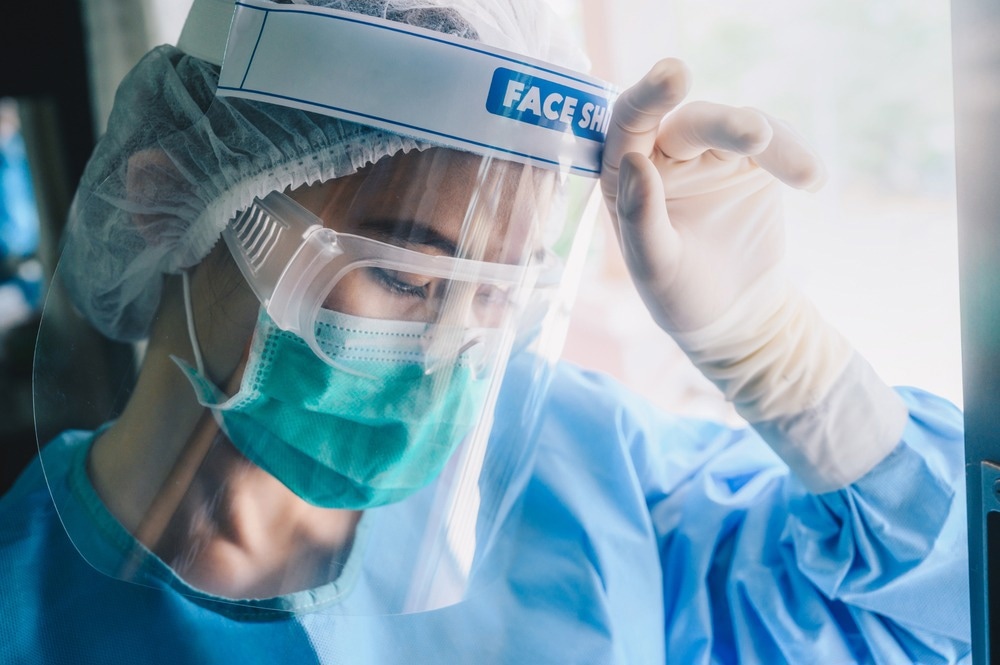In a recent study published in Alcohol Clinical and Experimental Research, researchers investigated whether unhealthy alcohol use (UAU) and shift work with subsequent circadian rhythm disruption could increase coronavirus disease 2019 (COVID-19) susceptibility among nurses.
 Study: Binge drinking alcohol and circadian misalignment in night shift nurses is associated with decreased resiliency to COVID-19 infection. Image Credit: Boyloso/Shutterstock.com
Study: Binge drinking alcohol and circadian misalignment in night shift nurses is associated with decreased resiliency to COVID-19 infection. Image Credit: Boyloso/Shutterstock.com
Background
Frontline healthcare personnel such as nurses are at an increased risk of severe acute respiratory syndrome coronavirus 2 (SARS-CoV-2) exposure. Severe SARS-CoV-2 infections have been reported among nurses despite the absence of known factors that enhance COVID-19 risks, such as diabetes, hypertension, and obesity, indicating that there may be other factors that enhance the risk of SARS-CoV-2 infections.
As elevated cytokine expression and inflammation are the main pathophysiological mechanisms underlying COVID-19 severity, pro-inflammatory factors could lower resiliency against COVID-19 among individuals exposed to SARS-CoV-2. The effects of UAU and circadian rhythm disturbances on the risk of COVID-19 are not well characterized and require further investigation.
About the study
In the present cross-sectional, prospective, and observational study, researchers determined the associations between excessive alcohol consumption, circadian misalignment among night shift nurses, and the risk of SARS-CoV-2 infection.
The study was conducted in collaboration with the American Nursing Association (ANA) to assess UAU using the Alcohol Use Disorders Identification Test (AUDIT) questionnaire and circadian chronotype or typology using the Munich Chronotype Questionnaire Shift (MCTQ Shift) among nurses. In addition, the participants filled out the Short Form 8 (SF-8), the Sleep Hygiene Index (SHI), the Patient-Reported Outcomes Measurement Information System (PROMIS), and validated SARS-CoV-2 infection questionnaires, which were distributed online to all participants from May 2020 to April 2021.
Demographic data [age, body mass index (BMI), sex, race, and postal code] were obtained to evaluate socioeconomic status. The team included adult female and male nurses aged 69 years and above who worked day, evening, night, or rotational shifts at hospitals or outpatient clinics. Nurses aged below 18 years and those who could not speak English fluently were excluded from the analysis.
Univariate and multivariate logistic regression modeling was performed to calculate the odds ratios (ORs). In addition, latent class analysis (LCA) was performed. Follow-up surveys were conducted every four to eight weeks. Individuals with a below-average prevalence of AUDIT items were considered low-risk drinkers, those reporting problematic drinking habits, including feeling remorse or guilt after consuming alcohol, being unable to recall after drinking alcohol, and being unable to stop after initiating alcohol use, were considered high-risk drinkers. Individuals drinking at least six drinks monthly and three to four drinks were considered binge drinkers.
Results
A total of 3,351 individuals clicked the web-based survey link, 82% of whom (n=2,734) were eligible, and 1,582 showed a willingness to participate; however, only 750 filled out the survey questionnaires. The mean participant age was 39 ; 92% were female; 55% (406 individuals) were Filipinos; and 32% were Whites (240 individuals).
A median score of 3.0 was obtained for the AUDIT questionnaire, with 25% of individuals (188) considered alcohol misusers. Compared to non-alcohol misusers, individuals who misused alcohol were younger (35 versus 41 years), had a greater likelihood of being White (43% versus 29%), had disturbed sleep (feeling non-refreshed or restless, PROMIS scores 53 versus 52), sleep-related impairments (daytime drowsiness, PROMIS scores 54 versus 51), worse sleep hygiene (SHI scores 21 versus 17), and were more likely to provide care to a SARS-CoV-2-positive individual (79% versus 72%).
The primary drivers of differences between alcohol misusers and non-misusers were altered sleep schedules and feeling stressed, angry, or worried before sleeping. Among individuals with high-risk features, alcohol misuse was related to a later chronotype. Compared to non-binge drinkers, binge drinkers had an increased likelihood of working at night (46% versus 24%), and binge drinkers and high-risk drinkers were less likely to work standard shifts (7.0% versus >20% in other subtypes.
Compared to the standard shift, the night shift increased the chances of SARS-CoV-2 infection by more than two-fold (OR 2.7). The LCA analysis showed that binge drinkers had double the likelihood of SARS-CoV-2 infection than individuals with low-risk features (OR 2.1). Adjusting for alcohol subtype maintained the relationship between night shift and SARS-CoV-2 infection [adjusted OR (aOR) 2.7] and that between the risk of COVID-19 and work shift.
Conclusion
Overall, the study findings showed that night shifts and binge drinking may increase the risk of SARS-CoV-2 infections in nurses. Further research must be conducted to explore the mechanisms underlying the association to decrease the COVID-19 burden among healthcare workers.